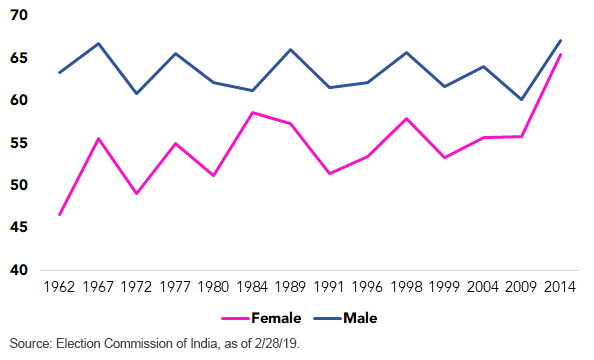A Sneak Peek into the World’s Largest and Most Expensive Democratic Exercise


There’s a common saying in the intellectual circles of Delhi, India: “Elections are the biggest festivals of a democracy."
This once-every-five or so years festivity is back, and nearly one billion voters in the world’s largest democracy are ready to celebrate.
India’s Election Commission announced federal election dates while I was recently in the country. The election is a month-long process, held in seven stages from April 11 through May 19.
The World’s Largest Democracy
While the United States is the world’s oldest and most mature democracy, India has the unique distinction of being the largest. After its independence in 1947, with memories of World War II and fascism still fresh, founders of this new republic—but ancient civilization—realized that the checks and balances of a democracy ensure smooth and sustained growth.
Since then, India has had 16 federal elections. Here are some key facts and figures for this mammoth exercise.
- Nearly 1 Billion Voters – World’s Largest!
More than 830 million people were eligible to vote during the 2014 election, and more than 550 million actually cast their vote (an impressive > 66% turnout!). This time, the size of the electorate is expected to swell to over 900 million, which is more than the populations of all European countries combined.
- Expected Bill of $7 Billion – World’s Most Expensive!
About $6.5 billion was spent in the 2016 U.S. presidential election, making it the most expensive election on this planet to date. But India’s 2019 federal elections are estimated to cost over $7 billion, a 40% increase from the $5 billion bill of India’s 2014 federal elections. With almost one billion voters, this is nearly $7 spent per voter. In 2014, one 98-year-old man in the Himalayan mountains trekked several miles to vote—something that he had done in every election held since India’s independence in 1947.
- Over 10 Million Polling Staff – Trains to Helicopters
Coordinating the polling of one billion voters is an incredible logistical challenge. There will be one million polling stations across the country and over 10 million polling staff, 600,000 security personnel, 600 special trains and 100 helicopters.
- Over One Million Polling Stations – From Hermits to Leopards and Lions
Ensuring that each of India’s one billion voters gets reasonable access to polling stations, including in some of its remotest locations, is a humongous task. Polling locations range from 15,000 feet above sea level in the Himalayas to one for a sole hermit living deep in the leopard- and lion-ruled jungles of Western India.
- Over 65% Female Voter Turnout – Pink Is the Unofficial Color!
Women outnumbered men in the last election in half of India’s states. Since its first election, the gap between men and women in voter participation has been gradually narrowing. In the last elections, women even managed a few polling stations; this time, the Election Commission plans to set up more “pink polling booths.”
Male & Female Participation in India's Federal Elections

- Leveraging Technology – From Electronic Voting to Online Advertisements!
Indian elections are almost entirely ballot-less, with electronic voting using over two million electronic voting machines (EVMs). An estimated $500 million will be spent on online advertisements by political parties. India has half a billion Internet and smartphone users, 300 million Facebook users and 200 million WhatsApp users. With a tech-savvy population of this size, technology is everywhere.
- Over 450 Political Parties and 8,000 Candidates – A Fight of Epic Proportions!
Over 8,000 candidates across 450 political parties are running for 545 seats in the lower house, or “Lok Sabha” (which would correspond to the House of Representatives in the U.S.). The winner would have to surpass the magic number of 273 to govern the world’s largest democracy.
When India had its first national elections in 1951, little did its forefathers know of the juggernaut that the election machinery would become in the decades to follow. But as they say with any festival, “the more, the merrier.”
In a relatively short time, within a turbulent part of the world, a complex society and a vast country, India has truly exemplified the Festival of Democracy.


